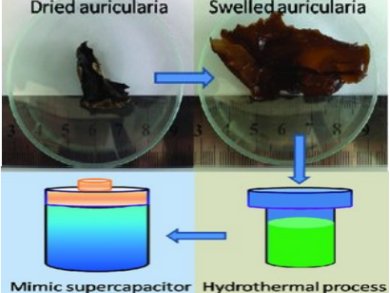Fungi have been widely applied in the food and pharmaceutical industries due to their abundance and essential roles in decomposing organic matter and nutrient cycling. Their potential applications in material science, however, have been largely ignored.
Xiurong Yang and colleagues, Chinese Academy of Sciences, have used the fungus auricularia as a source of carbonaceous material for supercapacitor electrodes. The fungus consists of a smooth outer surface and wrinkled internal architecture which is interspersed with microchannels which allows it to swell on contact with water. The team applied a simple hydrothermal pyrolysis technique which fractured the crude biomass. The high proportion of heteroatoms retained in the resultant carbon led to capacitance. The material showed higher operating voltage, volumetric capacitance, and maximum energy than carbon isolated from seaweed and commercially available carbon.
This presents a cheap and renewable alternative to capacitors made from transition metal oxides or carbon activated via high-temperature or harsh chemical routes.
- Promising Carbons for Supercapacitors Derived from Fungi
H. Zhu, X. Wang, F. Yang, X. Yang
Adv. Mater. 2011.
DOI: 10.1002/adma.201100901



